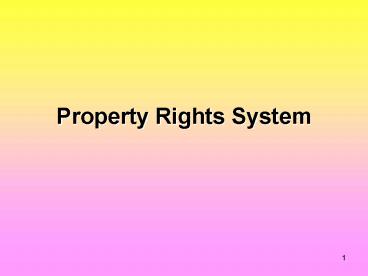Property Rights System - PowerPoint PPT Presentation
1 / 17
Title:
Property Rights System
Description:
As a result, the value of the fishing ground (rent) is zero. 0. Qa. AFC. Pa. ARP. 5. 8 ... value of the common property will be reduced by competition to zero. ... – PowerPoint PPT presentation
Number of Views:74
Avg rating:3.0/5.0
Title: Property Rights System
1
Property Rights System
2
Private property rights
- Exclusive rights to use, to transfer and to earn
income from the property are clearly delineated - Voluntary exchanges among people would be
possible when transaction costs are zero, or low
enough - Allocative efficiency (or Pareto Condition) could
be attained
3
Common property rights
- No exclusive rights to use, to transfer and to
earn income from the property - Nobody could exclude the others from using the
property - Market exchange and price system become
impossible - Non-price methods of allocation must appear to
distinguish winners from losers
4
Suppose there is a common fishing ground.
- Assume the wage rate of fisherman (a) is 30 and
the price of output (x) is 10.
5
Case 1 Common fishing ground
6
Case 1 Common fishing ground
The total output will be equally shared among all
participated fishermen, where no one has an
exclusive right of the economic rent or income.
So, their returns are equal to the average
revenue product.
7
Case 1 Common fishing ground
At equilibrium, the no. of fisherman is 5 (ARP
AFC). The total revenue product is 150. The total
factor cost of fisherman is 150, too. As a
result, the value of the fishing ground (rent) is
zero.
8
Case 2 Private fishing ground
The owner of the fishing ground who maximizes his
wealth would consider the marginal revenue
product of fisherman.
9
Case 2 Private fishing ground
At equilibrium, the no. of fisherman is 3 (MRP
MFC). The total revenue product is 120 but the
total factor cost of fisherman is 90 only. As a
result, the value of the fishing ground (rent) is
30 which is maximized.
10
Private vs Common Property Rights
Pa
- At Qp, MRP MFC, economic rent of the property
is maximized.
- At Qc, ARP AFC, economic rent of the property
is zero. - The existence of the deadweight loss would reduce
the value of the property. - Such situation is called as Dissipation of Rent.
11
Private vs Common Property Rights
- Under the common property right system, economic
rent will be absorbed by the deadweight loss
created by the unrestrained competition. - The rental value of the common property will be
reduced by competition to zero. - Dissipation of rent appears when the rental value
is absorbed by the cost. - In order to retain economic rent, competition
must be restrained, e.g. by clear delineation of
property rights.
12
- In reality, as people are constrained maximizers,
there would not be pure common properties. - People would use various ways to restrain common
competition. - Under private property right system, price
mechanism is always used. It is the only method
which could maximize economic rent. - When property rights are not well-defined, people
would minimize the dissipation of rent by
adopting non-price criterion or criteria (i.e.
non-price competition).
13
Price Control and Dissipation of Rent
- Under price control, private property rights will
be attenuated. The right to earn income from the
property will be weakened. - Suppose the price of good X is fixed below the
equilibrium level. What would happen?
14
- When the price is fixed at P1, the winner at the
margin is willing to pay P2 which is higher than
the controlled money price P1. - It implies that only the controlled money price
is not useful to allocate good X among
competitors.
15
- Non-price criterion or criteria would exist to
allocate good X to the winners. - In order to be a winner, competitors have to give
up additional resources. - The full price of good X will be P2. Those who
could not pay P2 will be losers.
16
- At the margin, the non-money price will be P2
P1. - Such resources will be sacrificed by winners but
may not received by the sellers (e.g. under
first-come, first-served basis). - There will be a non-exclusive income.
17
- In order to capture the non-exclusive income,
people may perform various kinds of activities. - Such rent-seeking activities would sacrifice a
great amount of resources (costs of transaction). - As a result, the net gain must be smaller.
- Although dissipation of rent happens, it must be
kept at minimum. - It is interesting that there are different types
of non-price competition. - When we consider all constraints in our theories,
equilibrium must be attained, i.e., we could
derive implications that are refutable by facts. - The so-called disequilibrium is not refutable.

